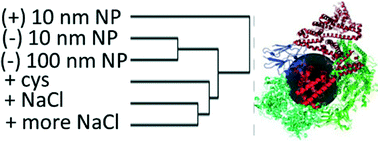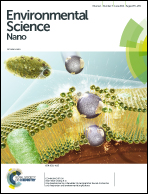Silver nanoparticle protein corona composition compared across engineered particle properties and environmentally relevant reaction conditions†
Abstract
Engineered silver nanoparticles (AgNPs) undergo profound chemical transformations in the environment. Upon exposure to biological systems, a protein corona forms to coat the NPs, altering NP bioavailability, toxicity and environmental fate. Although recent studies have explored the importance of the engineered properties of NPs in the formation of protein coronas, less is known about the impact of environmental conditions. In this work, protein corona populations are compared across AgNPs of varied sizes and surface coatings, as well as in aqueous solutions with additives that mimic environmentally relevant conditions. Bioinformatic analysis of the protein corona populations reveals that, in low buffer concentrations, the formation of the protein corona is dominated by electrostatic interactions between the proteins and NPs. The influence of electrostatics is attenuated by addition of solution additives such as sodium chloride and cysteine. Protein enrichment on the NPs is compared across 6 samples with varied AgNP engineered properties and solution conditions. Clustered results reveal that engineered surface coatings strongly mediate protein corona formation. However, under conditions that mimic varied biological and environmental systems, the protein affinities are similar. Indeed, the AgNP protein coronas characterized under environmentally relevant conditions share 70% of the protein corona population. Results provide insight into the relative importance of engineered NP properties and uncontrollable environmental variables, such as solution reaction conditions, in the formation of protein coronas.


 Please wait while we load your content...
Please wait while we load your content...